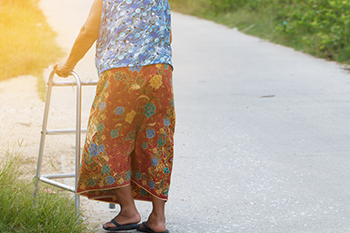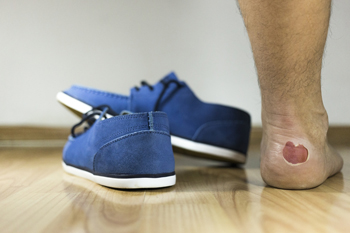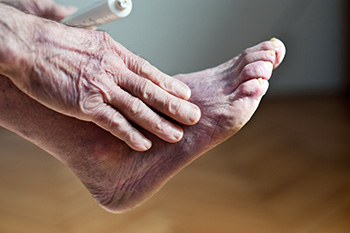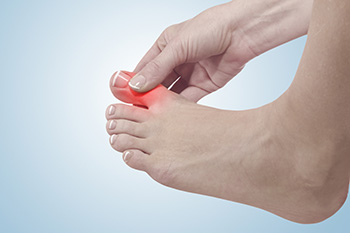Connect With Us
Blog
Items filtered by date: May 2022
Plantar Warts Can Be Treated!
Falling May Lead To Painful Foot Conditions

Research has shown that one of the leading causes of injury among older people is falling. It can lead to a fractured foot and other bones may break when falling occurs. As we age, our bones can become brittle and the risk of falling increases. There are preventive methods that may help to prevent falling. These can include having routine medical examinations performed which can also be useful in updating existing medication. Additionally, it is beneficial to remove worn rugs in the living area and to improve lighting in the house. Many people have installed grab bars in the shower and toilet areas as this can help to provide stability. Incorporating a gentle exercise regime as part of your daily routine can help to improve muscle strength and wearing shoes that fit correctly is instrumental in the prevention of falls. Using walkers or canes can be crucial in maintaining balance and it is important to refrain from drinking excess alcohol. Several foot conditions can result from falling so it is advised that you confer with a podiatrist who can help you with effective prevention methods.
Preventing falls among the elderly is very important. If you are older and have fallen or fear that you are prone to falling, consult with one of our podiatrists from Southwest Podiatry. Our doctors will assess your condition and provide you with quality advice and care.
Every 11 seconds, an elderly American is being treated in an emergency room for a fall related injury. Falls are the leading cause of head and hip injuries for those 65 and older. Due to decreases in strength, balance, senses, and lack of awareness, elderly persons are very susceptible to falling. Thankfully, there are a number of things older persons can do to prevent falls.
How to Prevent Falls
Some effective methods that older persons can do to prevent falls include:
- Enrolling in strength and balance exercise program to increase balance and strength
- Periodically having your sight and hearing checked
- Discuss any medications you have with a doctor to see if it increases the risk of falling
- Clearing the house of falling hazards and installing devices like grab bars and railings
- Utilizing a walker or cane
- Wearing shoes that provide good support and cushioning
- Talking to family members about falling and increasing awareness
Falling can be a traumatic and embarrassing experience for elderly persons; this can make them less willing to leave the house, and less willing to talk to someone about their fears of falling. Doing such things, however, will increase the likelihood of tripping or losing one’s balance. Knowing the causes of falling and how to prevent them is the best way to mitigate the risk of serious injury.
If you have any questions, please feel free to contact our offices located in Dallas, and Carrollton, TX . We offer the newest diagnostic and treatment technologies for all your foot care needs.
Why Do Blisters Develop on the Feet?

A blister is a small area that looks like a bubble and can be bothersome when it develops on the feet. It happens as a result of excess friction from wearing shoes or socks that do not fit correctly. The consistent rubbing of the material on the skin can lead to a blister. It is filled with a protective liquid, which protects the area as new skin develops. It will gradually drain on its own, when it is no longer needed for protection. Many people choose to wear a bandage over the blister, which may be helpful in preventing premature drainage. Other reasons a blister may develop can include frostbite, sunburn, or possibly an allergic reaction from an insect bite. Some patients find that pressure is reduced in the shoes when orthotics are worn, or when socks that have extra padding are worn. Research has indicated that having dry skin may lead to getting blisters, in addition to wearing shoes without socks and increasing speed and mileage while running or walking. If you have blisters on your feet, please confer with a podiatrist for additional caring and prevention techniques.
Blisters are prone to making everyday activities extremely uncomfortable. If your feet are hurting, contact one of our podiatrists of Southwest Podiatry. Our doctors can provide the care you need to keep you pain-free and on your feet.
Foot Blisters
Foot blisters develop as a result of constantly wearing tight or ill-fitting footwear. This happens due to the constant rubbing from the shoe, which can often lead to pain.
What Are Foot Blisters?
A foot blister is a small fluid-filled pocket that forms on the upper-most layer of the skin. Blisters are filled with clear fluid and can lead to blood drainage or pus if the area becomes infected.
How Do Blisters Form?
Blisters on the feet are often the result of constant friction of skin and material, usually by shoe rubbing. Walking in sandals, boots, or shoes that don’t fit properly for long periods of time can result in a blister. Having consistent foot moisture and humidity can easily lead to blister formation.
Prevention & Treatment
It is important to properly care for the affected area in order to prevent infection and ease the pain. Do not lance the blister and use a Band-Aid to provide pain relief. Also, be sure to keep your feet dry and wear proper fitting shoes. If you see blood or pus in a blister, seek assistance from a podiatrist.
If you have any questions, please feel free to contact our offices located in Dallas, and Carrollton, TX . We offer the newest diagnostic and treatment technologies for all your foot care needs.
Foods and Exercises May Help Poor Circulation

It is common for diabetic patients to have poor circulation in their feet. This is often the result of elevated blood sugar levels. Neuropathy can accompany this. It can be difficult to feel cuts and wounds on the feet, and the blood vessels can diminish in size. There are several methods to help poor circulation in the feet. These can consist of getting regular foot examinations, monitoring glucose levels, and wearing diabetic socks. Research has indicated that performing specific exercises may improve circulation in the feet. Some exercises can include cardiovascular activity such as walking or biking for five days per week. Additionally, it is important to keep blood pressure at a normal level and refrain from walking barefoot. Foods that are rich in vitamin C may help to naturally thin the blood, and it may help to incorporate foods that are rich in fiber into your daily food plan. If your feet are affected by poor circulation, it is strongly suggested that you confer with a podiatrist who can help you to manage this condition.
While poor circulation itself isn’t a condition; it is a symptom of another underlying health condition you may have. If you have any concerns with poor circulation in your feet contact one of our podiatrists of Southwest Podiatry. Our doctors will treat your foot and ankle needs.
Poor Circulation in the Feet
Peripheral artery disease (PAD) can potentially lead to poor circulation in the lower extremities. PAD is a condition that causes the blood vessels and arteries to narrow. In a linked condition called atherosclerosis, the arteries stiffen up due to a buildup of plaque in the arteries and blood vessels. These two conditions can cause a decrease in the amount of blood that flows to your extremities, therefore resulting in pain.
Symptoms
Some of the most common symptoms of poor circulation are:
- Numbness
- Tingling
- Throbbing or stinging pain in limbs
- Pain
- Muscle Cramps
Treatment for poor circulation often depends on the underlying condition that causes it. Methods for treatment may include insulin for diabetes, special exercise programs, surgery for varicose veins, or compression socks for swollen legs.
As always, see a podiatrist as he or she will assist in finding a regimen that suits you. A podiatrist can also prescribe you any needed medication.
If you have any questions, please feel free to contact our offices located in Dallas, and Carrollton, TX . We offer the newest diagnostic and treatment technologies for all your foot care needs.
Osteoarthritis May Be Damaging Your Big Toe Joint

The cartilage in a joint can become damaged and worn down from the condition known as osteoarthritis (OA). This can expose bones in the damaged joint and cause them to rub together. OA often attacks the first metatarsophalangeal joint (at the base of the big toe). A variety of symptoms may occur including pain, swelling, and limited mobility. The body may respond by creating more bone which can develop into bone spurs that cause visible bumps, calluses, or a bunion in the big toe. In time, the pain can become more of a burning sensation and stiffness may set in to the point where the big toe becomes fixed (hallux rigidus) and unbendable. Age can be a contributing factor to OA, as well as prior injuries, obesity, and a genetic predisposition to the disease. Losing weight, taking anti-inflammatories, and icing the area may provide some relief from OA in the big toe. A podiatrist can provide orthotics, braces or splints, recommend proper shoes, suggest specific exercises and even use injectable corticosteroids to relieve pain and reduce swelling. In some cases, surgery may be necessary to remove deteriorated cartilage or repair/replace a severely damaged joint. Contact a podiatrist if you believe OA is causing pain and swelling in your big toe joint.
Arthritis can be a difficult condition to live with. If you are seeking treatment, contact one of our podiatrists from Southwest Podiatry. Our doctors can provide the care you need to keep you pain-free and on your feet.
Arthritic Foot Care
Arthritis is a term that is commonly used to describe joint pain. The condition itself can occur to anyone of any age, race, or gender, and there are over 100 types of it. Nevertheless, arthritis is more commonly found in women compared to men, and it is also more prevalent in those who are overweight. The causes of arthritis vary depending on which type of arthritis you have. Osteoarthritis for example, is often caused by injury, while rheumatoid arthritis is caused by a misdirected immune system.
Symptoms
- Swelling
- Pain
- Stiffness
- Decreased Range of Motion
Arthritic symptoms range in severity, and they may come and go. Some symptoms stay the same for several years but could potentially get worse with time. Severe cases of arthritis can prevent its sufferers from performing daily activities and make walking difficult.
Risk Factors
- Occupation – Occupations requiring repetitive knee movements have been linked to osteoarthritis
- Obesity – Excess weight can contribute to osteoarthritis development
- Infection – Microbial agents can infect the joints and trigger arthritis
- Joint Injuries – Damage to joints may lead to osteoarthritis
- Age – Risk increases with age
- Gender –Most types are more common in women
- Genetics – Arthritis can be hereditary
If you suspect your arthritis is affecting your feet, it is crucial that you see a podiatrist immediately. Your doctor will be able to address your specific case and help you decide which treatment method is best for you.
If you have any questions, please feel free to contact our offices located in Dallas, and Carrollton, TX . We offer the newest diagnostic and treatment technologies for all your foot care needs.


